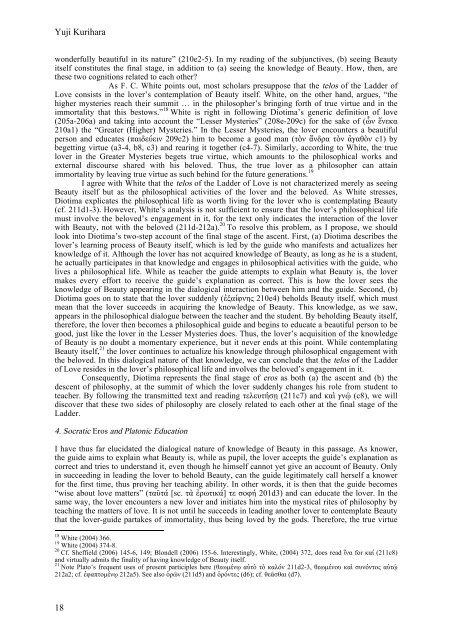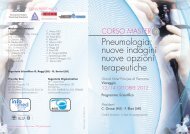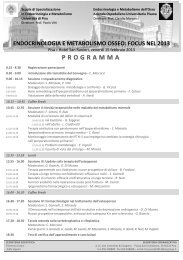You also want an ePaper? Increase the reach of your titles
YUMPU automatically turns print PDFs into web optimized ePapers that Google loves.
Yuji Kurihara<br />
wonderfully beautiful in its nature” (210e2-5). In my reading of the subjunctives, (b) seeing Beauty<br />
itself constitutes the final stage, in addition to (a) seeing the knowledge of Beauty. How, then, are<br />
these two cognitions related to each other?<br />
As F. C. White points out, most scholars presuppose that the telos of the Ladder of<br />
Love consists in the lover’s contemplation of Beauty itself. White, on the other hand, argues, “the<br />
higher mysteries reach their summit … in the philosopher’s bringing forth of true virtue and in the<br />
immortality that this bestows.” 18 White is right in following Diotima’s generic definition of love<br />
(205a-206a) and taking into account the “Lesser Mysteries” (208e-209c) for the sake of (ὧν ἕνεκα<br />
210a1) the “Greater (Higher) Mysteries.” In the Lesser Mysteries, the lover encounters a beautiful<br />
person and educates (παιδεύειν 209c2) him to become a good man (τὸν ἄνδρα τὸν ἀγαθὸν c1) by<br />
begetting virtue (a3-4, b8, c3) and rearing it together (c4-7). Similarly, according to White, the true<br />
lover in the Greater Mysteries begets true virtue, which amounts to the philosophical works and<br />
external discourse shared with his beloved. Thus, the true lover as a philosopher can attain<br />
immortality by leaving true virtue as such behind for the future generations. 19<br />
I agree with White that the telos of the Ladder of Love is not characterized merely as seeing<br />
Beauty itself but as the philosophical activities of the lover and the beloved. As White stresses,<br />
Diotima explicates the philosophical life as worth living for the lover who is contemplating Beauty<br />
(cf. 211d1-3). However, White’s analysis is not sufficient to ensure that the lover’s philosophical life<br />
must involve the beloved’s engagement in it, for the text only indicates the interaction of the lover<br />
with Beauty, not with the beloved (211d-212a). 20 To resolve this problem, as I propose, we should<br />
look into Diotima’s two-step account of the final stage of the ascent. First, (a) Diotima describes the<br />
lover’s learning process of Beauty itself, which is led by the guide who manifests and actualizes her<br />
knowledge of it. Although the lover has not acquired knowledge of Beauty, as long as he is a student,<br />
he actually participates in that knowledge and engages in philosophical activities with the guide, who<br />
lives a philosophical life. While as teacher the guide attempts to explain what Beauty is, the lover<br />
makes every effort to receive the guide’s explanation as correct. This is how the lover sees the<br />
knowledge of Beauty appearing in the dialogical interaction between him and the guide. Second, (b)<br />
Diotima goes on to state that the lover suddenly (ἐξαίφνης 210e4) beholds Beauty itself, which must<br />
mean that the lover succeeds in acquiring the knowledge of Beauty. This knowledge, as we saw,<br />
appears in the philosophical dialogue between the teacher and the student. By beholding Beauty itself,<br />
therefore, the lover then becomes a philosophical guide and begins to educate a beautiful person to be<br />
good, just like the lover in the Lesser Mysteries does. Thus, the lover’s acquisition of the knowledge<br />
of Beauty is no doubt a momentary experience, but it never ends at this point. While contemplating<br />
Beauty itself, 21 the lover continues to actualize his knowledge through philosophical engagement with<br />
the beloved. In this dialogical nature of that knowledge, we can conclude that the telos of the Ladder<br />
of Love resides in the lover’s philosophical life and involves the beloved’s engagement in it.<br />
Consequently, Diotima represents the final stage of eros as both (a) the ascent and (b) the<br />
descent of philosophy, at the summit of which the lover suddenly changes his role from student to<br />
teacher. By following the transmitted text and reading τελευτήσῃ (211c7) and καὶ γνῷ (c8), we will<br />
discover that these two sides of philosophy are closely related to each other at the final stage of the<br />
Ladder.<br />
4. Socratic Eros and Platonic Education<br />
I have thus far elucidated the dialogical nature of knowledge of Beauty in this passage. As knower,<br />
the guide aims to explain what Beauty is, while as pupil, the lover accepts the guide’s explanation as<br />
correct and tries to understand it, even though he himself cannot yet give an account of Beauty. Only<br />
in succeeding in leading the lover to behold Beauty, can the guide legitimately call herself a knower<br />
for the first time, thus proving her teaching ability. In other words, it is then that the guide becomes<br />
“wise about love matters” (ταῦτά [sc. τὰ ἐρωτικά] τε σοφή 201d3) and can educate the lover. In the<br />
same way, the lover encounters a new lover and initiates him into the mystical rites of philosophy by<br />
teaching the matters of love. It is not until he succeeds in leading another lover to contemplate Beauty<br />
that the lover-guide partakes of immortality, thus being loved by the gods. Therefore, the true virtue<br />
18 White (2004) 366.<br />
19 White (2004) 374-8.<br />
20 Cf. Sheffield (2006) 145-6, 149; Blondell (2006) 155-6. Interestingly, White, (2004) 372, does read ἵνα for καί (211c8)<br />
and virtually admits the finality of having knowledge of Beauty itself.<br />
21 Note Plato’s frequent uses of present participles here (θεωµένῳ αὐτὸ τὸ καλόν 211d2-3, θεωµένου καὶ συνόντος αὐτῷ<br />
212a2; cf. ἐφαπτοµένῳ 212a5). See also ὁρῶν (211d5) and ὁρόντες (d6); cf. θεᾶσθαι (d7).<br />
18




